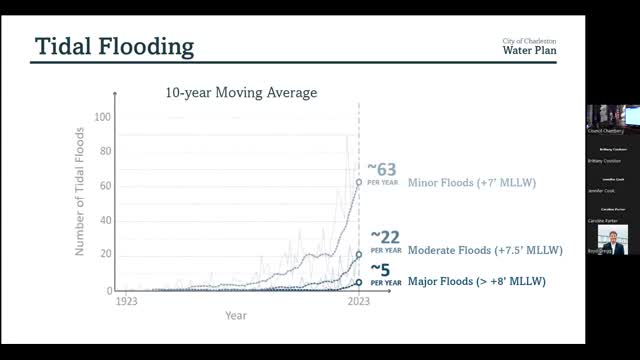Charleston faces tidal flood crisis as major events surge
August 27, 2024 | Charleston City, Charleston County, South Carolina
This article was created by AI summarizing key points discussed. AI makes mistakes, so for full details and context, please refer to the video of the full meeting. Please report any errors so we can fix them. Report an error »

Charleston is experiencing a significant increase in tidal flooding, with the average number of tidal floods recorded in Charleston Harbor rising from approximately 20 per decade in the 2000s to 63 over the last ten years. Notably, 71% of the 45 major tidal floods recorded since 1921 have occurred since 2015, highlighting an alarming trend in flood frequency. The most severe events include Hurricane Hugo, which remains the flood of record, and two major floods from the past year—Hurricane Idalia and a December nor'easter, the latter being the highest non-tropical tide ever recorded in the harbor.
In response to these challenges, the city has invested in various flood mitigation strategies, including the construction of berms and the installation of over 40 check valves to manage stormwater and prevent flooding in low-lying areas. While these measures have proven effective for minor tidal events, officials acknowledge that they are not foolproof solutions, particularly as tides continue to rise.
Charleston's stormwater management has also come under scrutiny, with recent rainfall events exceeding the historical 100-year storm threshold. The city updated its stormwater design standards in 2020 to include a 10% safety factor, but experts warn that outdated NOAA data may not accurately reflect current rainfall patterns.
Additionally, the city has initiated a groundwater monitoring network to better understand groundwater levels and their impact on flooding. Recent studies indicate that Charleston is sinking at a rate of 2.2 inches per decade due to groundwater extraction, further exacerbating flood risks.
As part of a comprehensive water plan, city officials are exploring nature-based solutions to enhance resilience against flooding. This includes leveraging the region's natural features, such as coastal marshes and wetlands, which play a crucial role in absorbing rainfall and mitigating storm impacts.
The discussions underscore the urgent need for continued investment in flood management infrastructure and adaptive strategies to address the growing threat of tidal flooding in Charleston.
In response to these challenges, the city has invested in various flood mitigation strategies, including the construction of berms and the installation of over 40 check valves to manage stormwater and prevent flooding in low-lying areas. While these measures have proven effective for minor tidal events, officials acknowledge that they are not foolproof solutions, particularly as tides continue to rise.
Charleston's stormwater management has also come under scrutiny, with recent rainfall events exceeding the historical 100-year storm threshold. The city updated its stormwater design standards in 2020 to include a 10% safety factor, but experts warn that outdated NOAA data may not accurately reflect current rainfall patterns.
Additionally, the city has initiated a groundwater monitoring network to better understand groundwater levels and their impact on flooding. Recent studies indicate that Charleston is sinking at a rate of 2.2 inches per decade due to groundwater extraction, further exacerbating flood risks.
As part of a comprehensive water plan, city officials are exploring nature-based solutions to enhance resilience against flooding. This includes leveraging the region's natural features, such as coastal marshes and wetlands, which play a crucial role in absorbing rainfall and mitigating storm impacts.
The discussions underscore the urgent need for continued investment in flood management infrastructure and adaptive strategies to address the growing threat of tidal flooding in Charleston.
View full meeting
This article is based on a recent meeting—watch the full video and explore the complete transcript for deeper insights into the discussion.
View full meeting